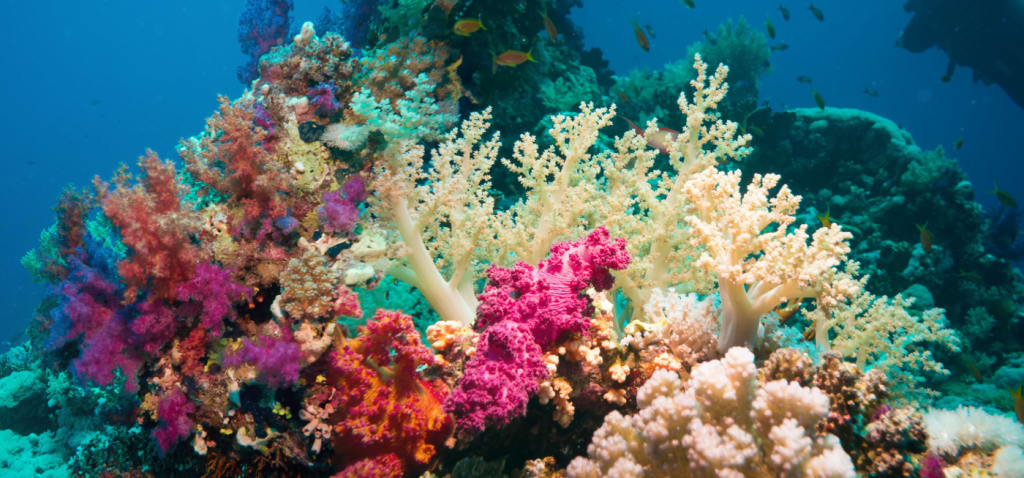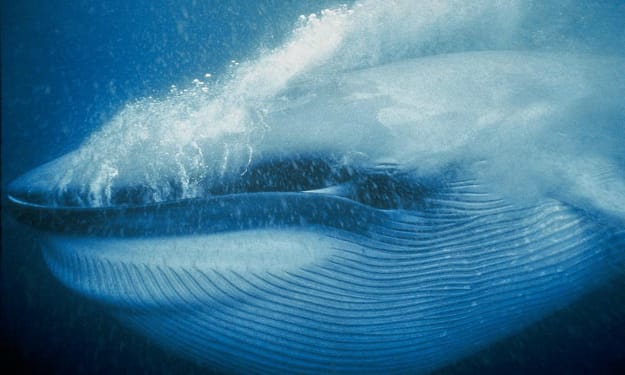
From microscopic plankton to the largest whale, the ocean has a greater variety of plants and animals than any other environment in the many different habitats it provides. Because our planet looks blue from outer space it has earned the nickname “the blue planet." 71% of the Earth’s surface is covered by water and 96% of this water is salt water making up the oceans that cover the planet all merging into each other to form the biggest habitat on earth.
Ocean habitats range from tropical reefs to the frozen polar ice fields, each with its own range of challenges for the organisms that live there.
Coral Reefs
Coral reefs provide an amazing habitat in tropical and sub-tropical waters that support a wide variety of marine species in their complex ecosystems. A coral reef's community is home to many different plants and animals, most notably small colourful fish, sea slugs, starfish, sea urchins, and sea anemones. A coral reef is made up of millions and millions of tiny polyps. Polyps are tiny animals have soft bodies with one end closed and the other end a mouth surrounded by tentacles which have stinging cells. They secrete hard limestone skeletons and live, and die, on top of each other to form the coral. The richness of the life in coral reefs has lead to them being called the "rainforests of the sea."
The Pelagic Zone – The Open Sea
The pelagic zone or the open ocean away from the coastlines has several habitats depending on how deep the water is.
The 21,000 different species of fish that live in the ocean have evolved to live in many different ocean habitats. They can live anywhere from the surface waters of the ocean to the cold, dark depth. The fast swimming, efficient predators such as swordfish, tuna, marlins, and sharks can cover thousands of miles a year.
The Ocean Floor
Flat fish like flounders and plaice are much more at home moving slowly over the ocean floor feeding on worms and mollusks. There isn’t any plant life on the ocean floor at great depths, as there is no light. Food that does reach the ocean floor includes dead plankton and faeces from fish and mammals. Animals that look like plants can live on the ocean floor, including sea anemones and sponges. There are organisms that crawl over the sea bed and burrow into it such as starfish, prawns, sea slugs, crabs, and lobsters.
Very deep in the ocean where there is no light, fish have developed their own light sources to attract prey and signal to other fish, such as the lantern fish and the angler fish.
Deep in the ocean are the Hydrothermal Vents. They are underwater geysers formed in cracks made by the movement of tectonic plates at an average depth of 7,000 feet. The water is heated by the underground magma to temperatures over 700F and contains minerals like hydrogen sulphide. Amazingly, hundreds of species of marine life can not just live but thrive in these geysers.
The Intertidal Zone – Beaches and Coasts
Where the sea and the land meet is called the intertidal zone. The tides affect this area more than anywhere else. At high tide, the zone is covered with water and at low tide, the sea bed is exposed. The sea bed can be sandy, rocky, or covered by mudflats providing many different habitats. This is where rock pools form that provide homes at low tide to a great variety of organisms. These organisms have adapted to live in this environment that changes several times a day.
There are many different factors which influence each of these ocean habitats and the creatures which inhabit them have had to evolve in different ways so that they can live there. These factors include:
Temperature
The water in the oceans has layers at different temperatures, warmer at the surface and colder the deeper you go. Temperature is critical for life. Enzymes, the building blocks of life, make chemical reactions possible within a living organism. They are highly temperature dependent, having only a limited temperature range when they are active. A 3 difference in temperature can make a major difference to the metabolic rate of an organism, doubling it, or halving it. Animals in the sea need to keep their temperature a little higher than the water they live in, which takes a lot of energy, and means they need to eat more. Grazing fish are much more susceptible to changes in temperature than predators.
Salt Levels
As marine animals live in water, their bodies need to be able to maintain a constant level of body salts which is always different to that in the water around them. There is an enormous difference between the amount of salt in fresh water, none, and that in seawater, 3.5%. The salinity gradually changes as the water runs out of rivers into estuaries and river mouths and out into the sea. The salinity of seawater remains fairly constant throughout the oceans but some inland seas have totally different salt levels.
The ability to float is also affected by salt levels. As salt water is heavier than fresh water, it means that it can provide more buoyancy for the organisms that live there.
Tides
Tides affect the coastal areas of the ocean, the intertidal or littoral zones. This means that the top few metres of the sea are moved by waves twice a day. The organisms that live in these zones have to be very specialised as they need to adapt to dehydration, heat, and cold and need to be able to live in very salty rock pools.
Currents
The waters of the ocean are affected by great ocean currents. These can be thousands of kilometres long and can be warm or cold. These currents are formed by wind, global circulation, and tides. Tidal currents, caused by the wind blowing along the coast, move the warm surface layer of water either towards the shore or out to sea.
Currents caused by the tide, have a major effect on animals that filter feed as they mix waters of different temperatures, salinity, and nutrients and move the plankton around four times a day. These are faster than the global circulation currents that affect the climate. Global currents move the warmth from tropical waters to the poles and the cold from the poles to the tropics.
Wind
Wind only affects sea creatures living in intertidal zones. For these organisms, the wind can dry them out much more quickly than heat or sunshine. Wind also causes waves which can change the floor of shallow harbours, changing a muddy sea bed into a sandy one. It can also cause the build up of sand on beaches that can only be home to very specialised organisms.
Light
The deeper under the ocean you go, the less light there is. Not only is there less light but its quality changes too. The infrareds disappear first, then the ultraviolets, the reds and last of all the yellow. There are several factors that affect visibility under water, and there is a great deal of difference between muddy estuaries, coasts, barrier islands, and open sea. Plankton also affects visibility, the thicker it is the less that can be seen. Plants need light to photosynthesise to produce energy. Different species need different amounts of light, some can live closer to the sun as they have pigments to protect them, other are iridescent so they can get more energy out of less light. Near the coast at low tide, the sun can make it very hot at low tide so that there are large differences in the body temperatures of the creatures that live there.
The Sea Bed
The sea bed or substrate is an important factor in ocean habitats. The substrate can be muddy, rocky, hard, soft, pebbly, coarse, smooth, grainy or made of shells. It can be arched, broken, caved, fissured, tunnelled or shelved. Leaves and roots can also make up the substrate.
Food
Phytoplankton is the basis of the ocean food chain. They are microscopic plants that float close to the surface of the ocean where they can get the sunlight they need for to photosynthesise. The phytoplankton is eaten by zooplankton, which is the larvae of worms, corals, crabs, and jellyfish, and adult animals, such as krill, copepods, and tiny shrimps. The zooplankton is eaten by fish and the fish are eaten by bigger fish that are in turn eaten by large predatory fish like sharks, seabirds, and mammals such as seals. Other large animals, such as whales, eat the zooplankton.
About the Creator
Clare Scanlan
I am passionate about writing! Passionate about animals, especially horses, passionate about women's and children's rights!





Comments
There are no comments for this story
Be the first to respond and start the conversation.